TOYOTA PRIUS PLUG-IN 2014 Manual Online
Manufacturer: TOYOTA, Model Year: 2014, Model line: PRIUS PLUG-IN, Model: TOYOTA PRIUS PLUG-IN 2014Pages: 724, PDF Size: 20.28 MB
Page 81 of 724
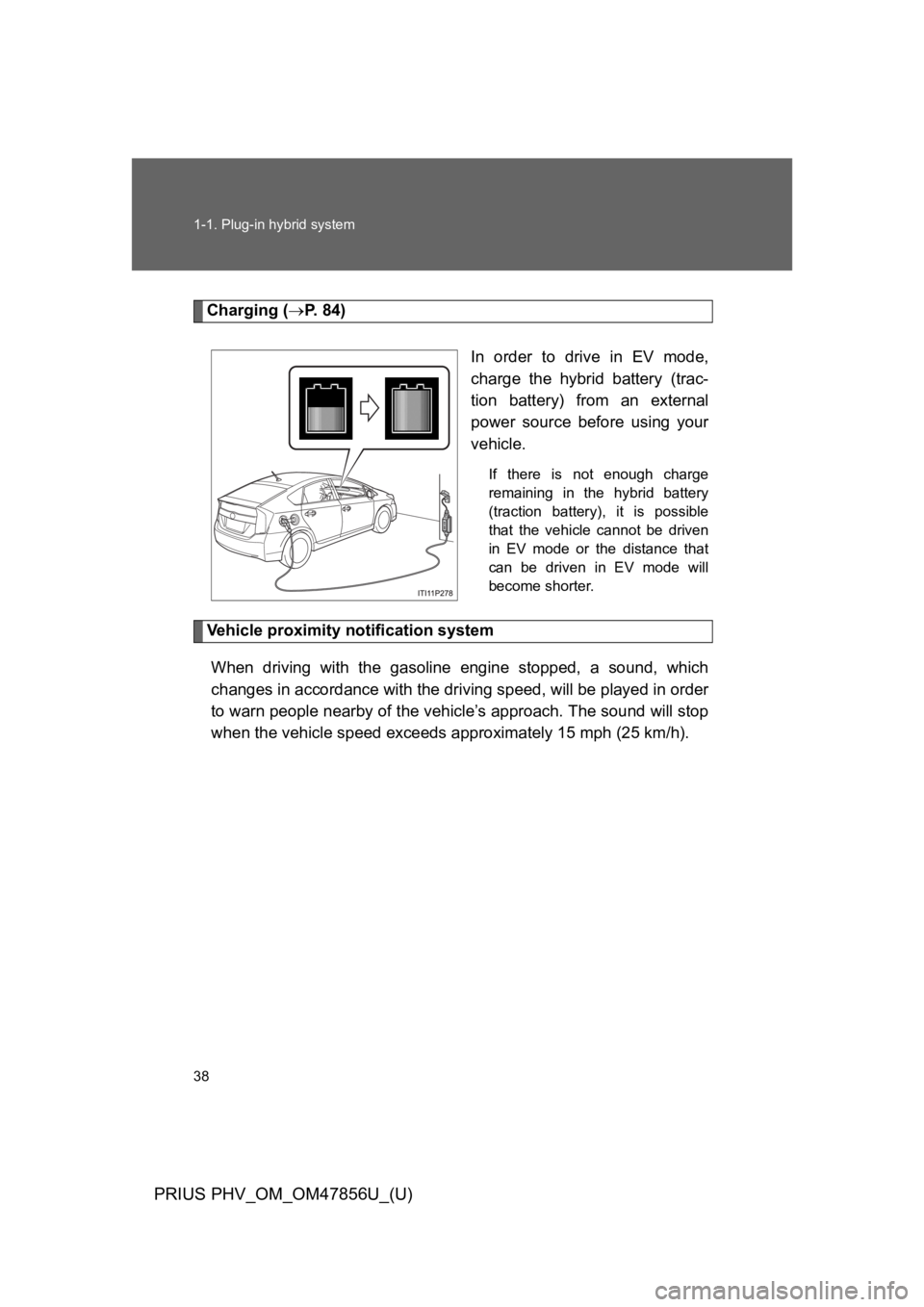
38
1-1. Plug-in hybrid system
PRIUS PHV_OM_OM47856U_(U)
Charging (→P. 8 4 )
In order to drive in EV mode,
charge the hybrid battery (trac-
tion battery) from an external
power source before using your
vehicle.
If there is not enough charge
remaining in the hybrid battery
(traction battery), it is possible
that the vehicle cannot be driven
in EV mode or the distance that
can be driven in EV mode will
become shorter.
Vehicle proximity notification system
When driving with the gasoline engine stopped, a sound, which
changes in accordance with the driving speed, will be played in order
to warn people nearby of the vehicle’s approach. The sound will stop
when the vehicle speed exceeds approximately 15 mph (25 km/h).
Page 82 of 724
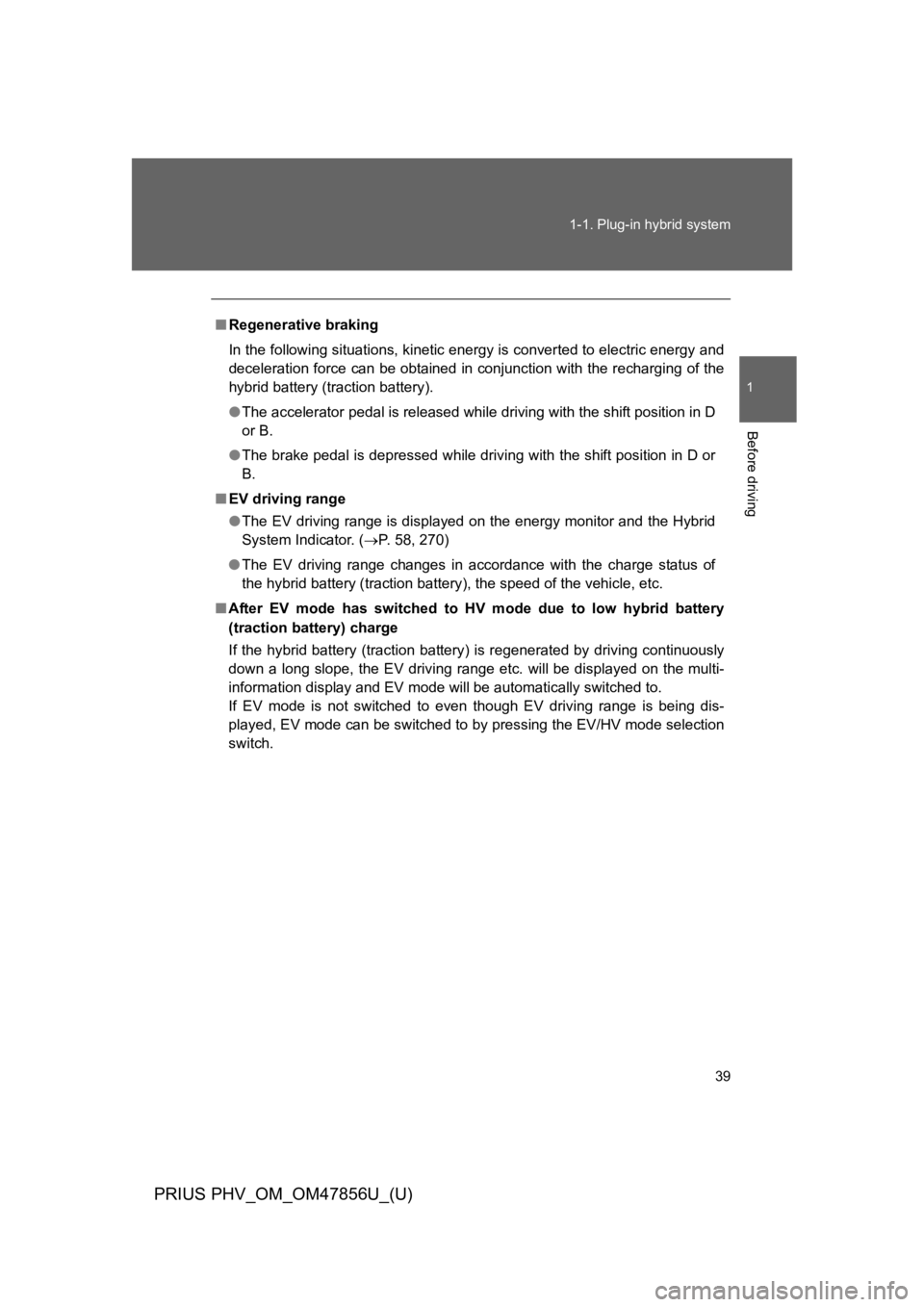
39
1-1. Plug-in hybrid system
1
Before driving
PRIUS PHV_OM_OM47856U_(U)
■Regenerative braking
In the following situations, kinetic energy is converted to electric energy and
deceleration force can be obtained in conjunction with the recharging of the
hybrid battery (traction battery).
●The accelerator pedal is released while driving with the shift position in D
or B.
●The brake pedal is depressed while driving with the shift position in D or
B.
■EV driving range
●The EV driving range is displayed on the energy monitor and the Hybrid
System Indicator. (→P. 5 8 , 2 7 0 )
●The EV driving range changes in accordance with the charge status of
the hybrid battery (traction battery), the speed of the vehicle, etc.
■After EV mode has switched to HV mode due to low hybrid battery
(traction battery) charge
If the hybrid battery (traction battery) is regenerated by driving continuously
down a long slope, the EV driving range etc. will be displayed on the multi-
information display and EV mode will be automatically switched to.
If EV mode is not switched to even though EV driving range is being dis-
played, EV mode can be switched to by pressing the EV/HV mode selection
switch.
Page 83 of 724
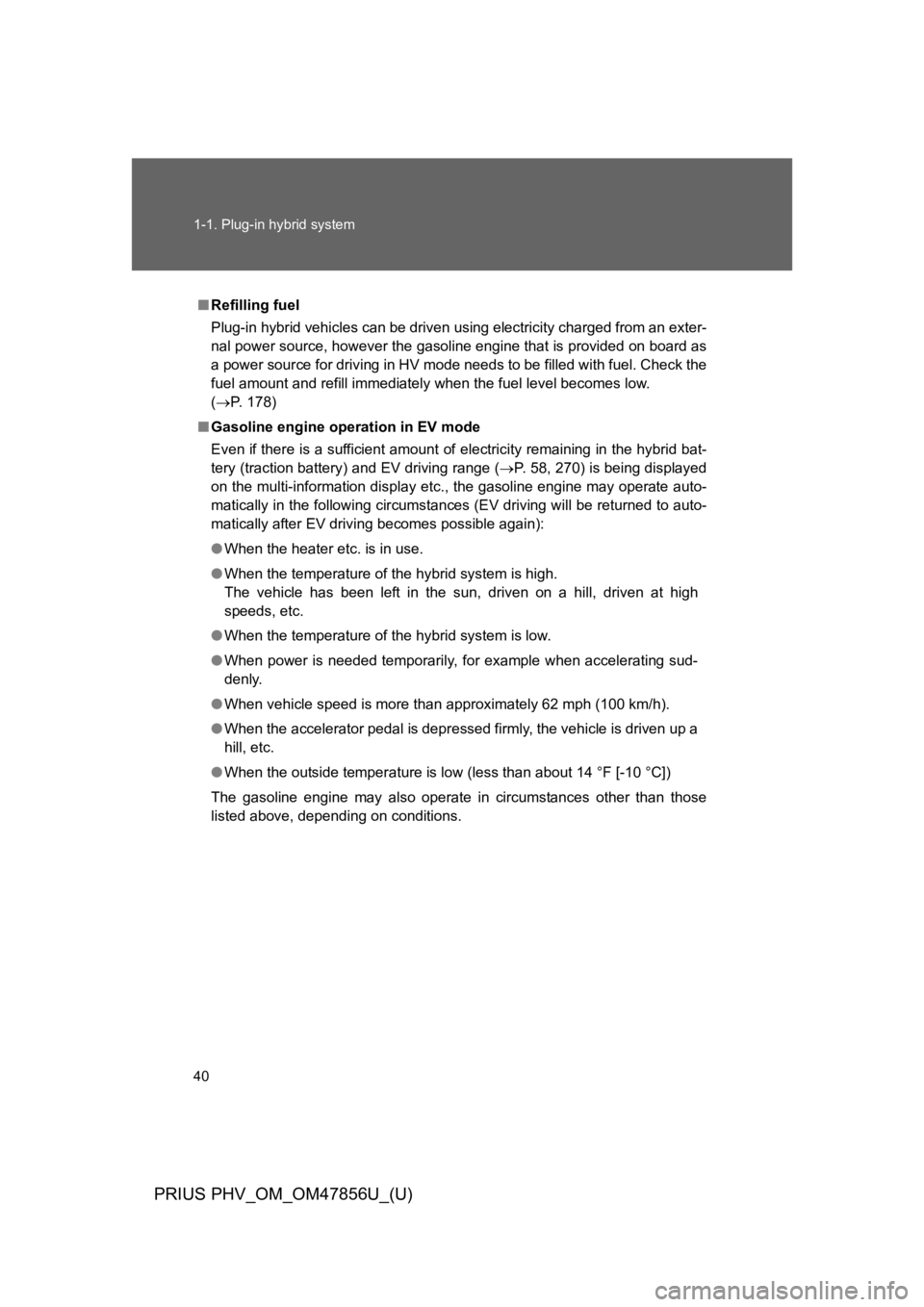
40
1-1. Plug-in hybrid system
PRIUS PHV_OM_OM47856U_(U)
■Refilling fuel
Plug-in hybrid vehicles can be driven using electricity charged from an exter-
nal power source, however the gasoline engine that is provided on board as
a power source for driving in HV mode needs to be filled with fuel. Check the
fuel amount and refill immediately when the fuel level becomes low.
(→P. 1 7 8 )
■Gasoline engine operation in EV mode
Even if there is a sufficient amount of electricity remaining in the hybrid bat-
tery (traction battery) and EV driving range (→P. 5 8 , 2 7 0 ) i s b e i n g d i s p l a y e d
on the multi-information display etc., the gasoline engine may operate auto-
matically in the following circumstances (EV driving will be returned to auto-
matically after EV driving becomes possible again):
●When the heater etc. is in use.
●When the temperature of the hybrid system is high.
The vehicle has been left in the sun, driven on a hill, driven at high
speeds, etc.
●When the temperature of the hybrid system is low.
●When power is needed temporarily, for example when accelerating sud-
denly.
●When vehicle speed is more than approximately 62 mph (100 km/h).
●When the accelerator pedal is depressed firmly, the vehicle is driven up a
hill, etc.
●When the outside temperature is low (less than about 14 °F [-10 °C])
The gasoline engine may also operate in circumstances other than those
listed above, depending on conditions.
Page 84 of 724
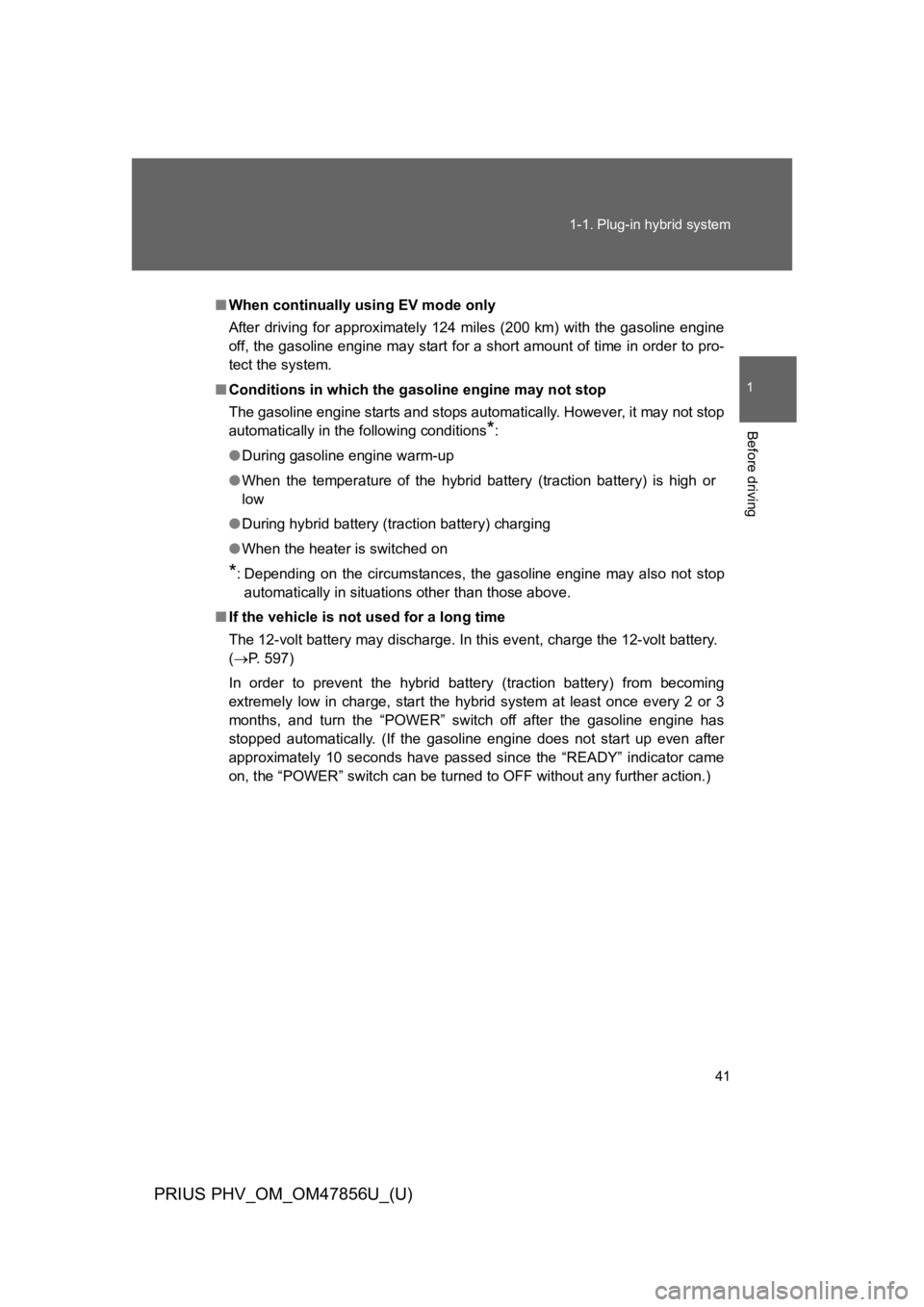
41
1-1. Plug-in hybrid system
1
Before driving
PRIUS PHV_OM_OM47856U_(U)
■When continually using EV mode only
After driving for approximately 124 miles (200 km) with the gasoline engine
off, the gasoline engine may start for a short amount of time in order to pro-
tect the system.
■Conditions in which the gasoline engine may not stop
The gasoline engine starts and stops automatically. However, it may not stop
automatically in the following conditions*:
●During gasoline engine warm-up
●When the temperature of the hybrid battery (traction battery) is high or
low
●During hybrid battery (traction battery) charging
●When the heater is switched on
*:Depending on the circumstances, the gasoline engine may also not stop
automatically in situations other than those above.
■If the vehicle is not used for a long time
The 12-volt battery may discharge. In this event, charge the 12-volt battery.
(→P. 5 9 7 )
In order to prevent the hybrid battery (traction battery) from becoming
extremely low in charge, start the hybrid system at least once every 2 or 3
months, and turn the “POWER” switch off after the gasoline engine has
stopped automatically. (If the gasoline engine does not start up even after
approximately 10 seconds have passed since the “READY” indicator came
on, the “POWER” switch can be turned to OFF without any further action.)
Page 85 of 724
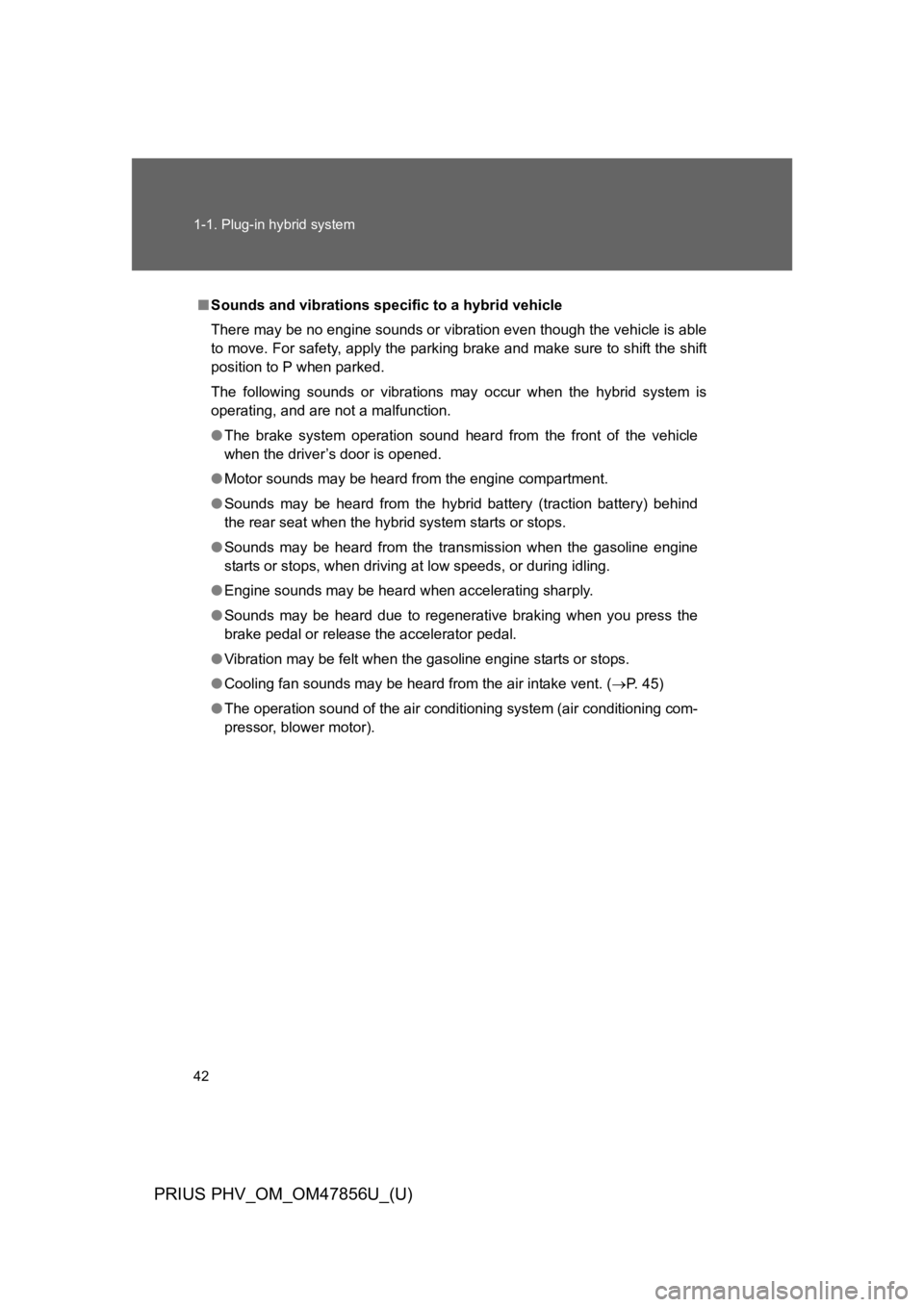
42
1-1. Plug-in hybrid system
PRIUS PHV_OM_OM47856U_(U)
■Sounds and vibrations specific to a hybrid vehicle
There may be no engine sounds or vibration even though the vehicle is able
to move. For safety, apply the parking brake and make sure to shift the shift
position to P when parked.
The following sounds or vibrations may occur when the hybrid system is
operating, and are not a malfunction.
●The brake system operation sound heard from the front of the vehicle
when the driver’s door is opened.
●Motor sounds may be heard from the engine compartment.
●Sounds may be heard from the hybrid battery (traction battery) behind
the rear seat when the hybrid system starts or stops.
●Sounds may be heard from the transmission when the gasoline engine
starts or stops, when driving at low speeds, or during idling.
●Engine sounds may be heard when accelerating sharply.
●Sounds may be heard due to regenerative braking when you press the
brake pedal or release the accelerator pedal.
●Vibration may be felt when the gasoline engine starts or stops.
●Cooling fan sounds may be heard from the air intake vent. (→P. 4 5 )
●The operation sound of the air conditioning system (air conditioning com-
pressor, blower motor).
Page 86 of 724
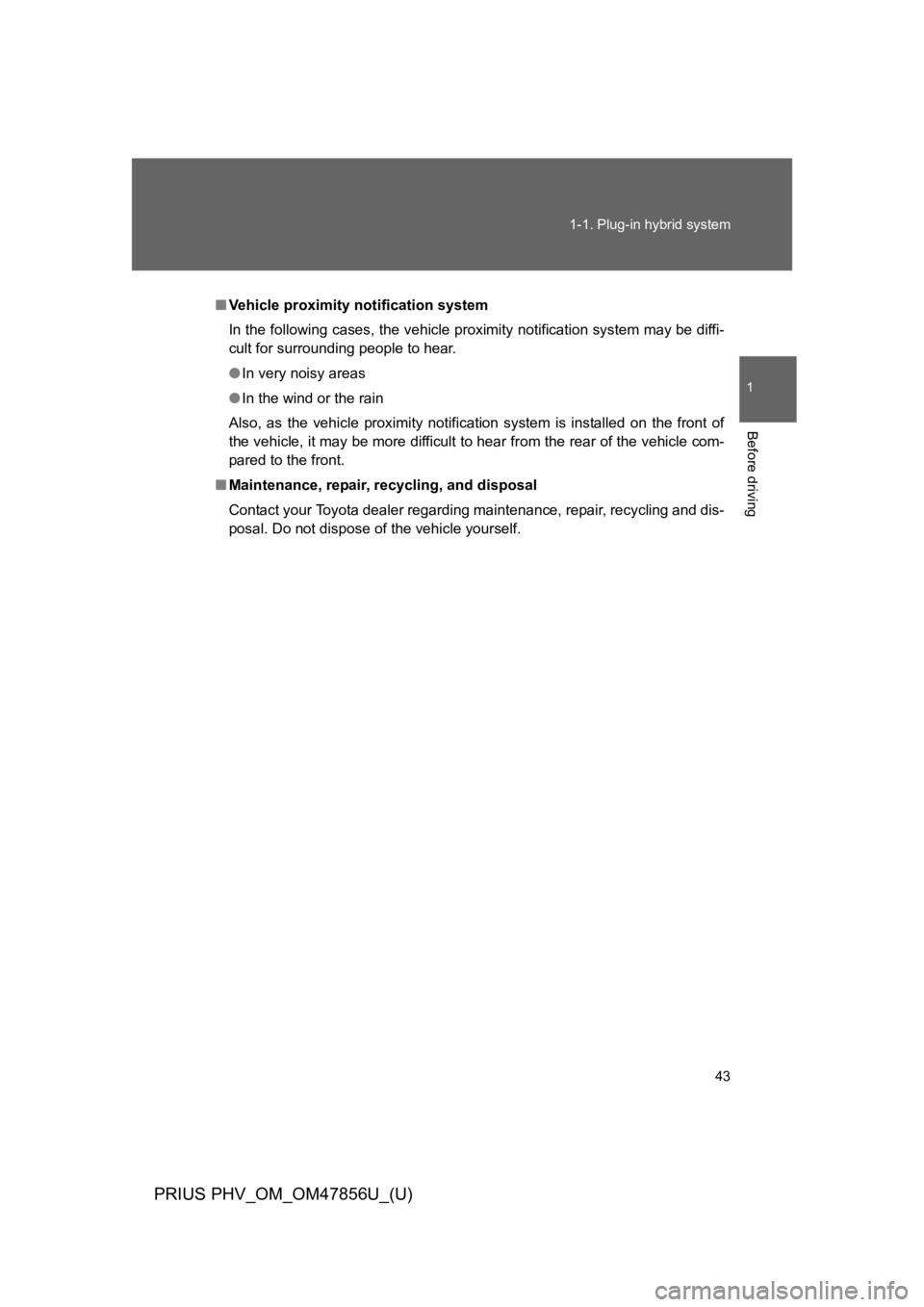
43
1-1. Plug-in hybrid system
1
Before driving
PRIUS PHV_OM_OM47856U_(U)
■Ve h i c l e p r o x i m i t y n o t i f i c a t i o n s y st e m
In the following cases, the vehicle proximity notification system may be diffi-
cult for surrounding people to hear.
●In very noisy areas
●In the wind or the rain
Also, as the vehicle proximity notification system is installed on the front of
the vehicle, it may be more difficult to hear from the rear of the vehicle com-
pared to the front.
■Maintenance, repair, recycling, and disposal
Contact your Toyota dealer regarding maintenance, repair, recycling and dis-
posal. Do not dispose of the vehicle yourself.
Page 87 of 724
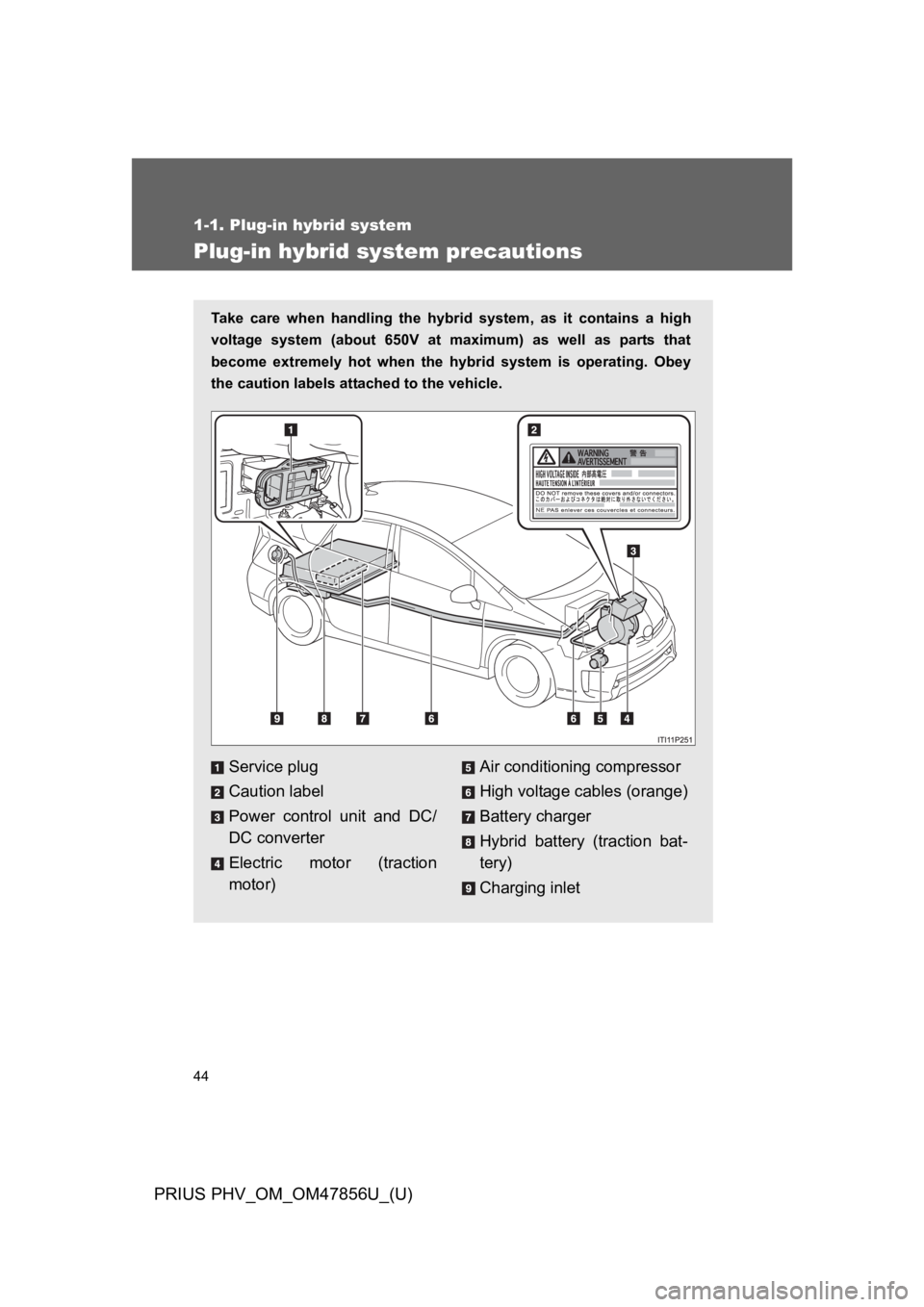
44
1-1. Plug-in hybrid system
PRIUS PHV_OM_OM47856U_(U)
Plug-in hybrid system precautions
Ta k e c a r e w h e n h a n d l i n g t h e h y b r i d s y s t e m , a s i t c o n ta i n s a h i g h
voltage system (about 650V at maximum) as well as parts that
become extremely hot when the hybrid system is operating. Obey
the caution labels attached to the vehicle.
Service plug
Caution label
Power control unit and DC/
DC converter
Electric motor (traction
motor)
Air conditioning compressor
High voltage cables (orange)
Battery charger
Hybrid battery (traction bat-
tery)
Charging inlet
Page 88 of 724
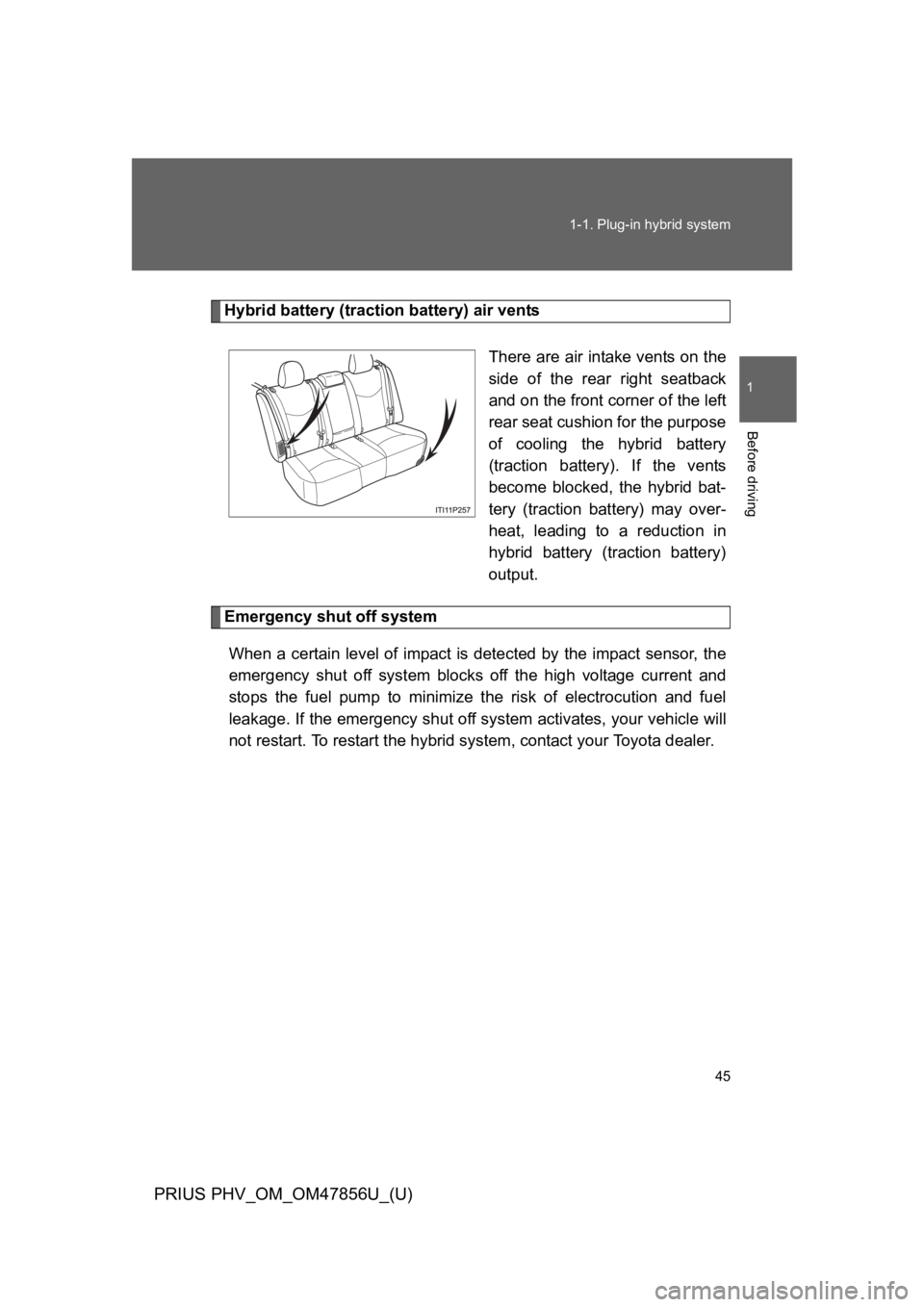
45
1-1. Plug-in hybrid system
1
Before driving
PRIUS PHV_OM_OM47856U_(U)
Hybrid battery (traction battery) air vents
There are air intake vents on the
side of the rear right seatback
and on the front corner of the left
rear seat cushion for the purpose
of cooling the hybrid battery
(traction battery). If the vents
become blocked, the hybrid bat-
tery (traction battery) may over-
heat, leading to a reduction in
hybrid battery (traction battery)
output.
Emergency shut off system
When a certain level of impact is detected by the impact sensor, the
emergency shut off system blocks off the high voltage current and
stops the fuel pump to minimize the risk of electrocution and fuel
leakage. If the emergency shut off system activates, your vehicle will
not restart. To restart the hybrid system, contact your Toyota dealer.
Page 89 of 724
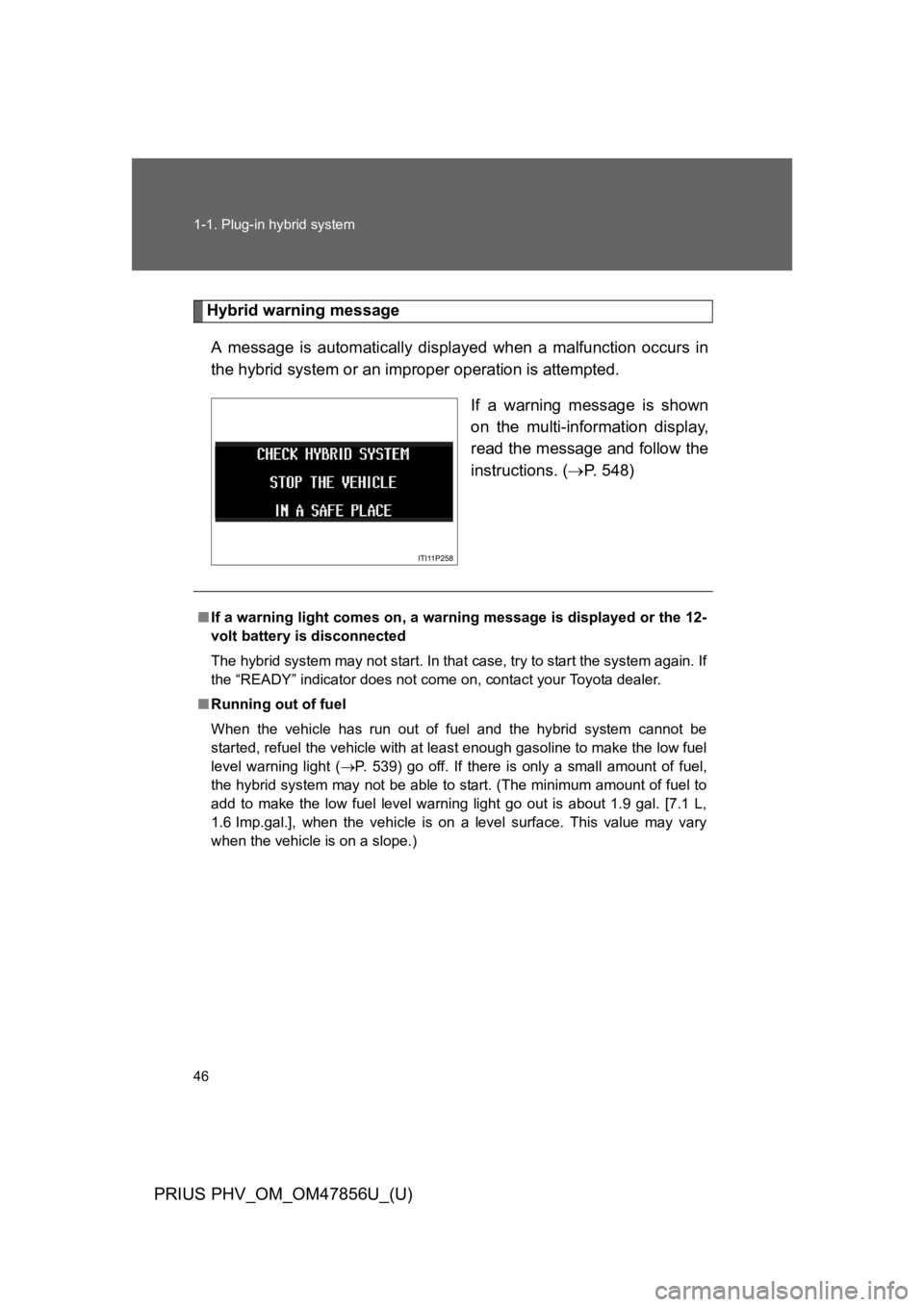
46
1-1. Plug-in hybrid system
PRIUS PHV_OM_OM47856U_(U)
Hybrid warning message
A message is automatically displayed when a malfunction occurs in
the hybrid system or an improper operation is attempted.
If a warning message is shown
on the multi-information display,
read the message and follow the
instructions. (→P. 5 4 8 )
■If a warning light comes on, a warning message is displayed or the 12-
volt battery is disconnected
The hybrid system may not start. In that case, try to start the system again. If
the “READY” indicator does not come on, contact your Toyota dealer.
■Running out of fuel
When the vehicle has run out of fuel and the hybrid system cannot be
started, refuel the vehicle with at least enough gasoline to make the low fuel
level warning light (→P. 5 3 9 ) g o o f f . I f t h e r e i s o n l y a s m a l l a m o u n t o f f u e l ,
the hybrid system may not be able to start. (The minimum amount of fuel to
add to make the low fuel level warning light go out is about 1.9 gal. [7.1 L,
1.6 Imp.gal.], when the vehicle is on a level surface. This value may vary
when the vehicle is on a slope.)
Page 90 of 724
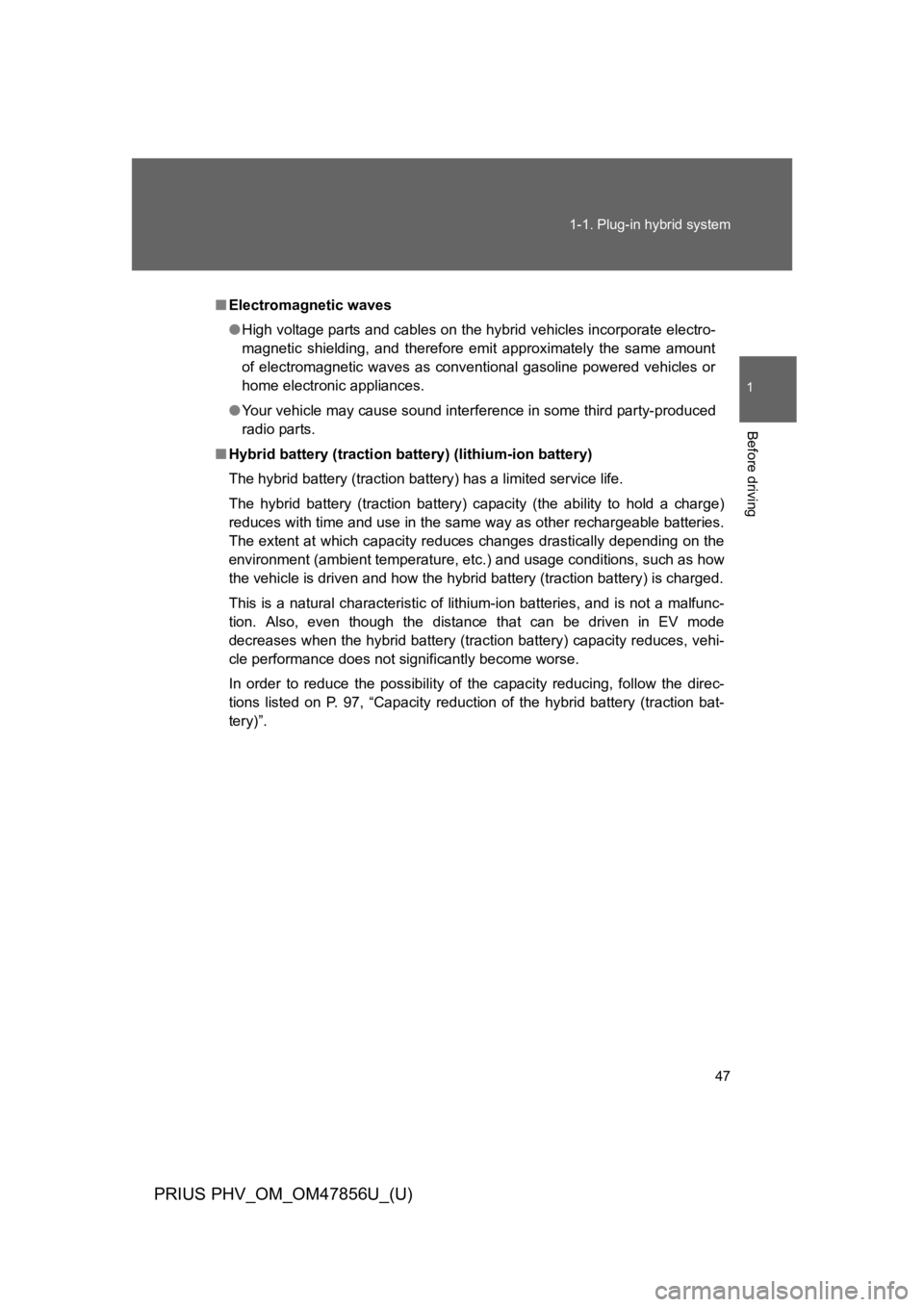
47
1-1. Plug-in hybrid system
1
Before driving
PRIUS PHV_OM_OM47856U_(U)
■Electromagnetic waves
●High voltage parts and cables on the hybrid vehicles incorporate electro-
magnetic shielding, and therefore emit approximately the same amount
of electromagnetic waves as conventional gasoline powered vehicles or
home electronic appliances.
●Yo u r v e h i c l e m a y c a u s e s o u n d i n t e r f e r e n c e i n s o m e t h i r d p a r t y - p r o d u c e d
radio parts.
■Hybrid battery (traction battery) (lithium-ion battery)
The hybrid battery (traction battery) has a limited service life.
The hybrid battery (traction battery) capacity (the ability to hold a charge)
reduces with time and use in the same way as other rechargeable batteries.
The extent at which capacity reduces changes drastically depending on the
environment (ambient temperature, etc.) and usage conditions, such as how
the vehicle is driven and how the hybrid battery (traction battery) is charged.
This is a natural characteristic of lithium-ion batteries, and is not a malfunc-
tion. Also, even though the distance that can be driven in EV mode
decreases when the hybrid battery (traction battery) capacity reduces, vehi-
cle performance does not significantly become worse.
In order to reduce the possibility of the capacity reducing, follow the direc-
tions listed on P. 97, “Capacity reduction of the hybrid battery (traction bat-
tery)”.